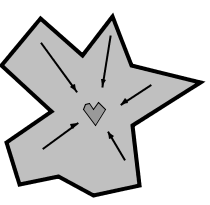- Psychology 2.0
Psychology 2.0
List of articles related to FIPP
On this page... (hide)
FIPP (Fodormik’s Integrated Paradigm for Psychology)
While playing the video press the "HQ" button (in the right bottom corner of the YouTube player) in order to improve playback quality
1. Introduction
Below we present a model that explains different aspects of human behavior. The model describes diverse kinds of human behavior – from religion to sex and from problem solving to intimate relationships – with the help of just a few basic concepts. At the same time, its results are congruent with those of the determining psychological schools and sub-sciences – analytic, cognitive and social psychologies – and explain them in a broader context. It integrates knowledge of human behavior found in common sense and the world religions, with the science of psychology. As we feel that we have managed to identify the key elements of human behavior, we do not consider it an exaggeration to propose that our model be used as the conceptual framework of psychology.
2. Principal concepts
FIPP operates with three known psychological concepts: Self, Environment and cognitive schemata. We redefine them as follows (henceforth the redefined Self and Environment concepts are indicated with capitals):
- The Self is the essence of a person that perceives the Environment.
- Environment is what the Self perceives. (For example, a specific man called John, a crowd, an eyelash, a bug on a leaf, the eyes of a wolf in a dark forest.) As a part of the Environment, social Environment refers to that group of people which is important for the Self. (For example, although there may be 20 others in a class, we may dress elegantly or behave better only for the sake of our boy- or girlfriend.)
- The cognitive schemata are the basic elements of thought. By structurally modelling the outside world they assist in the perception of the Environment for the Self (similar to a translation of the physical world to mental elements). For example, these are concepts (sleeping, solution, equation), shapes (sphere, whole, angular), categories (vertebrates, impressionist, business people) and technologies (tying bows, hitting a forehand, solving quadratic equations). The formation of a new schema creates a new model of the Environment; using that new model the Self is able to structure and perceive, control and react to its Environment.
The Self perceives its own size in relation to that of the Environment, and the proportion of these (Self resp. Environment) helps to characterize the ever changing relationship of these two entities; (for example, is the Self growing at the expense of the Environment at the moment? If it is, to what extent?) In addition, the relationship of the Self and the Environment is a key issue, as it shows the effectiveness of the adaptation of the Self i.e. how much it is subject to the Environment. (If the Self is smaller, the Environment controls it and vice versa.)
3. The model
The model introduces two new concepts according to the relationship of the size of the Self and the Environment:

- Self-Narrowing: when the Self perceives the Environment as becoming increasingly larger and itself becoming increasingly defenceless. The extreme is the demolition of the Self by the Environment.

- Self-Expanding: when the Self manages to control the Environment, and so the Environment becomes part of the Self, enriching rather than threatening it. In this way, the Self becomes bigger than the Environment. At the extreme, we can imagine the Self exploding into the Environment and destroying itself.
3.1 The FIPP-Pattern
With the help of the concepts of Self-Narrowing and -Expanding we can characterize human behavior in the following pattern:
the establishment of a new cognitive scheme changes the course of Self-Narrowing and converts it into Self-Expansion.
The new cognitive schema typically emerges from the integration of two or more incongruous cognitive schemata. The integration is a process when the old opposing schemata fall into smaller pieces (into their composing cognitive schemata) and from these pieces a new one arises that contains the major characteristic of the two previous ones. The new is superior to the two old ones. The everyday language calls the extremely narrow state of the Self preceding the birth of the new cognitive schema deadlock.
3.2 Supplement to the pattern: the constraint of communication
Following the establishment of the new cognitive schema the Self expands only for a short time as long as the Self does not hand it on to its social Environment (i.e. it is retained for itself). If the Self begins to spread the new cognitive schema, the Self continues to expand. During the process of expansion, energy is generated, which is used in spreading the new cognitive schema.
4. Example
Let us suppose that somebody has basic IT knowledge; knows how to switch on a computer, use a text editor and to save and print the typed text. They then encounter the following problem: any button he/she presses on the keyboard is shown on the monitor only in upper-case letters. What then happens?
- They try all of their existing cognitive schemata – restarts the editor, computer, et al – which could be relevant, but none of these works.
- They then ask themselves “That usually works fine, but now it does not. Am I doing something wrong?" They repeat the schemes many times without success.
- Deadlock comes: they are close to giving up, and consider their cognitive schemata regarding computers useless; "I hate stupid computers, and will use only pen and paper in future."
- They then begin to read the buttons on the keyboard and test the effect of the unknown ones. After pressing Caps Lock, then another letter…
- It works! "The solution is the Caps Lock key! It means capitals lock." Eureka feeling ensues: a new cognitive schema has been created!
- As they see that it works, they feel:
- additional energy; and
- an urge to communicate this to those who can appreciate their previous efforts and can profit from their new cognitive schema.
- Using their additional energy they begin to communicate; looking for friends, telling room-mates about the function of the new button &c.
- As they communicate so they feel increasingly happy, and the pride of owning and using a tool so that they can control their Environment (that part of their interest that they feel is important)
5. The consequences of the model
In the future, we will examine the utility of the model by comparing it with our empirical experience. Hence, we attempt to apply the model in various fields of life, and to examine the extent to which our model matches psychological theory.
The suggested topics follow. (Although these are separate texts, their sequence is not random.) The key words of the topics can be found in brackets:
- Arts (aesthetics, art psychology, thriller, horror, pornography, fashion, teacher, theatre, performance, illustration)
- Puzzle (solving a puzzle, interpreting the Bible)
- “Singing in the rain” and altruism (altruism, aggression, communication in team, smoking a spliff)
- Enlightenment (talent, career strategies)
- Different brains (career choice, the intellectual capital of a nation)
- Problem solving (problems, solutions, hunger for problems, narcissism)
- The right for anger (pro-social aggression, fanaticism, interrogation, brainwashing)
- Experience of evidence (eureka phenomenon, aha effect, gossip, novelty, teaching) and the “things that sound good”, when something seems better from far away than it really is
- Aggression-frustration (types of relationships, democracy, minority opinions, group decision mechanisms)
- Sex (types of orgasm, sexual organs, as a bodily surplus or deficit
- Narrowing of the Self and ignorance of information (focusing, relationships)
- Artificial influences on the size of the Self (smoking, boredom, drugs)
- Intimate relationships (self-surrender, sovereignty)
- Psychoanalytic theory about personality
- Function practice (cognitive schemata, ideas, archetypes)
- Confession and mental health
- dreams, being well-informed about only one topic and knowing nothing of others, nursery-school teachers, IT specialists, journalists, PR and communication experts, burnout, the age of 30, mourning, body image, sauna, bath, yoga, tennis, fencing, sports, team, national borders, harmony, intimacy, aura, double bed, Oedipus complex, complexity, empathy, truth)
- Happy end
- Social status and relaxing (solving a riddle, humour, creativity, comfort, the disadvantages of laziness, money)
- Exploration and arousal (discovery, routine, boredom)
- Groups (centre, periphery, defence, defencelessness, loneliness, group identity, power)
- Cognitive schemata
- Maslow’s hierarchy of needs
- Freedom and happiness
- Redemption (Jewry, Jesus, Christianity)
- Paths to Happiness (promiscuity, religions, confession, narratives, altruism, foundations, research, art, art collecting, family, wealth, travelling, gaining knowledge, reading, collecting, death, heaven and hell)
- Common frequency, harmony in communication on the level of emotions and of the body making empathy possible (hypnosis, dealing, business life, ability to climax, choosing a partner for life)
- Self-control and delay i.e. what is the fun in torturing ourselves? (failures, elegance, politeness)
- The personality typology of FIPP and dependencies (good, bad, aggression, detection of cheating, dependencies)
Advertisement
This article, and many others, is now available in print.
The book, 'Self-expansion', contains a generalized version of FIPP not available on psy2.org
 | Review copies are available for academics upon e-mail request |  |



